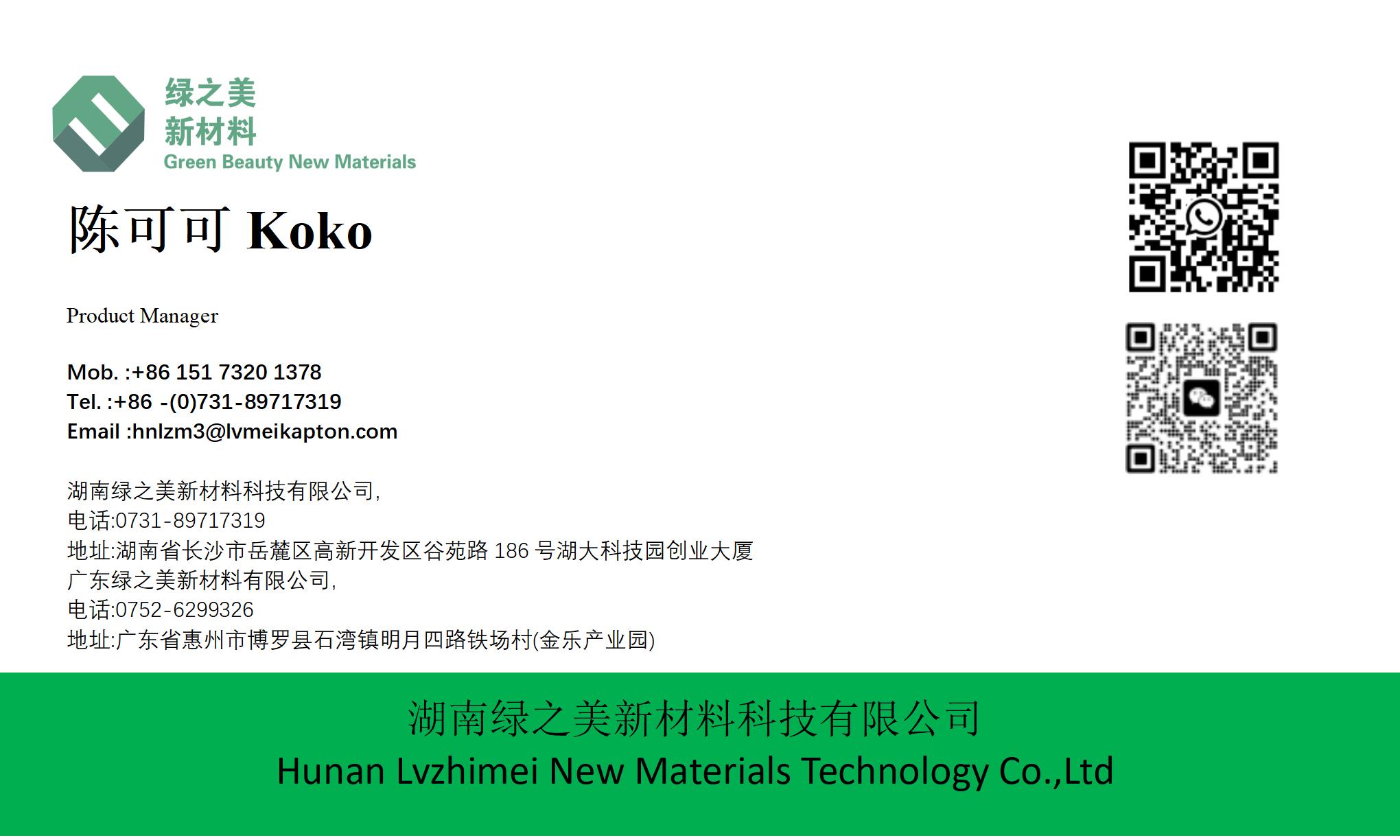hnlzm@lvmeikapton.com
+86 13787123465


Hunan Lvzhimei New Material Technology Co., Ltd.


NameDescriptionContent
When to Replace Polyimide Tape in Electronics |https://www.lvmeikapton.com/
Source:
|
Author:Koko Chan
|
Published time: 2025-05-23
|
5 Views
|
Share:
Polyimide tape, widely used in electronic devices for insulation, protection, and thermal management, plays a critical role in maintaining equipment reliability. Its unique properties—high-temperature resistance, chemical stability, and electrical insulation—make it essential in applications ranging from circuit board assembly to cable wrapping. However, over time, environmental stressors, thermal cycling, and mechanical wear can degrade tape performance, compromising the integrity of electronic systems. This article aims to outline key signs and scenarios indicating tape replacement, guiding technicians and maintenance personnel in proactive equipment upkeep.
When to Replace Polyimide Tape in Electronics
Date: May 23, 2025
IntroductionPolyimide tape, widely used in electronic devices for insulation, protection, and thermal management, plays a critical role in maintaining equipment reliability. Its unique properties—high-temperature resistance, chemical stability, and electrical insulation—make it essential in applications ranging from circuit board assembly to cable wrapping. However, over time, environmental stressors, thermal cycling, and mechanical wear can degrade tape performance, compromising the integrity of electronic systems. This article aims to outline key signs and scenarios indicating tape replacement, guiding technicians and maintenance personnel in proactive equipment upkeep.
1. Understanding Polyimide Tape DegradationPolyimide tape (commonly referred to as PI tape) is designed to withstand harsh conditions, but its longevity varies based on usage environment and handling. Degradation occurs through a combination of physical, chemical, and thermal processes, which manifest as visible or performance-related changes. Understanding these mechanisms is crucial for timely replacement.
1.1 Physical Degradation Signs
●
Discoloration: Yellowing or darkening of tape surface often indicates thermal aging. Excessive exposure to heat (e.g., prolonged operation near hot components) accelerates polymer chain degradation, altering color.
●
Peeling or Delamination: Separation of tape layers or detachment from substrates suggests adhesive failure. Mechanical stress (vibration, bending) or contamination (dust, oils) can weaken adhesion bonds.
●
Cracking: Visible surface cracks, particularly in high-temperature-resistant variants (e.g., PI material high-temperature resistant 300 tape), signal severe degradation. Cracks allow moisture ingress, increasing short-circuit risks.
●
Tear or Fraying: Physical damage from mishandling or abrasion reduces tape’s protective efficacy.
1.2 Performance Degradation
●
Adhesion Loss: Tape’s adhesive strength declines over time, particularly in humid environments. Testing adhesion (e.g., peel tests) can quantify performance reduction.
●
Thermal Conductivity Drop: For tapes used in thermal management, decreased conductivity (measured via thermal impedance tests) may overheat components.
●
Electrical Insulation Degradation: Resistance to voltage breakdown may diminish, posing electrostatic discharge (ESD) risks.
2. Scenarios Requiring Immediate ReplacementWhile visual inspections help identify degradation, specific scenarios demand prompt tape replacement to prevent equipment failure:
2.1 High-Temperature EnvironmentsIn applications exceeding 300°C (e.g., aerospace electronics or industrial furnaces), PI tape’s degradation accelerates. Cracks or discoloration in these contexts indicate material fatigue, necessitating replacement within 24-48 hours to avoid thermal runaway.
2.2 Humidity-Exposed SystemsOutdoor or high-humidity installations (e.g., marine electronics) require frequent inspections. If tape shows blistering, swelling, or adhesive delamination, replacement is imperative to prevent corrosion and short circuits.
2.3 Mechanical Stress-Prone DevicesVibrating equipment (e.g., automotive control units) subject tape to continuous mechanical stress. Peeling, fraying, or tear formation—regardless of other signs—warrant immediate replacement to ensure mechanical stability.
2.4 Aging Equipment (≥5 Years)Even under optimal conditions, PI tape’s lifespan typically ranges 3-5 years. For legacy systems approaching this threshold, proactive replacement enhances reliability, avoiding sudden failures.
3. Diagnostic Tools for Tape AssessmentTo supplement visual inspections, technicians can utilize:
●
Thermal Imaging: Identify hotspots under tape-covered components, indicating potential insulation failure.
●
Peel Strength Testing: Measure adhesive bond strength using ASTM D3330 standards.
●
Scanning Electron Microscopy (SEM): Analyze microcracks or surface degradation.
●
Dielectric Breakdown Voltage Testing: Validate electrical insulation integrity.
4. Replacement Procedures and Best PracticesEfficient tape replacement involves:
4.1 Preparation
●
Material Selection: Match replacement tape’s properties (temperature resistance, thickness, adhesive type) to original specifications.
●
Surface Cleaning: Remove debris and residue from substrates using isopropyl alcohol and lint-free wipes.
4.2 Application
●
Apply tape with 50% overlap for joints and edges.
●
Use heat guns (set ≤ tape’s max temperature) to enhance adhesion for high-temperature tapes.
●
Avoid stretching tape during application to prevent stress-induced cracking.
4.3 Post-Installation Verification
●
Conduct functional tests (e.g., thermal cycling, vibration tests) to validate tape performance.
●
Document replacement date and conditions for future reference.
5. Cost-Risk Analysis of Delayed ReplacementNeglecting timely tape replacement incurs significant costs:
Risk Category | Impacts |
Safety | Fire hazards from thermal failures; ESD damage to sensitive components. |
Downtime | Equipment malfunction leading to production halts or service interruptions. |
Repair Costs | Replacement of damaged components often exceeds tape replacement expenses. |
Reputation | Customer trust erosion due to unreliable equipment performance. |
6. Future Trends in Tape DurabilityOngoing research focuses on:
●
Nano-reinforced PI tapes with extended lifespans.
●
Self-healing polymers that autonomously repair microcracks.
●
Smart coatings with sensors monitoring degradation in real-time.
ConclusionProactive polyimide tape replacement is essential for maintaining electronic system reliability. By monitoring degradation signs, employing diagnostic tools, and adhering to replacement protocols, technicians can prevent costly failures while extending equipment lifespan. As materials science advances, future tapes with enhanced durability and self-monitoring capabilities promise even greater reliability in electronics maintenance.



Hunan Lvzhimei New Material Technology Co., Ltd.
Quick Links
Product Categories
© 2024 Hunan Lvzhimei New Material Technology Co., Ltd.All Rights Reserved. Designed by Erge
0731 - 89717319
hnlzm@lvmeikapton.com
+86 13787123465
Room 502, Chuangye Building, No186, Guyuan Road, High-Tech District, Changsha, Hunan, China
CONTACT



